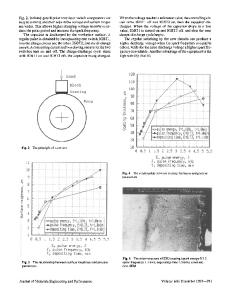The wear behavior of nitrogen-implanted metals
- PDF / 1,899,010 Bytes
- 9 Pages / 594 x 774 pts Page_size
- 26 Downloads / 371 Views
I.
INTRODUCTION
IT is
now well accepted that, in addition to modifying electrical properties, ion implantation can have a considerable effect on the near-surface, mechanical properties of metals. In particular much evidence concerning the improved wear resistance of implanted materials has appeared in the literature, as reviewed by a number of authors. ~'2"3 Despite the extensive data available on the wear behavior of implanted metals, the underlying effects are far from well understood. This is due to three factors. The wide range of ions, substrates, and implantation conditions used does not often permit meaningful comparison between data from different investigations. Few investigators have reported any detailed metallographic examinations of the wear process. The techniques which have been used to investigate the properties of implanted layers have often been insufficiently sensitive to study quantitatively such thin layers. Therefore it was decided to carry out a detailed investigation of a restricted range of materials using techniques which do permit the direct measurement of the characteristics of submicron surface layers. Previous attempts to explain the effect of ion implantation have usually been limited to the role of hardness increases produced by the implanted ions. Although a linear relationship between friction and wear is well established 4 for certain classes of material, it has been shown ~ that such a relationship will break down when changes in wear mechanism occur as a result of changes in the mechanical properties of a material. For example, the relative wear resistance of brittle ceramics is much poorer than that for ductile metals of a comparable hardness. Hence, properties such as fracture toughness and elongation to fracture play an important role in determining the wear resistance of a material. -s In view of this complex behavior, detailed investigation of the wear tracks was undertaken in order to examine the changes in wear mechanism which occurred. W.C. OLIVER is with Oak Ridge National Laboratory, Metals and Ceramics Division, P. O. Box X, Oak Ridge, TN 37831 ; R. HUTCHINGS is with the University of Cape Town, Department of Metallurgy and Materials Science, Rondebosch 7700, Republic of South Africa; and J.B. PETHICA is with Cavendish Laboratory, Madingley Road, Cambridge, CB 3 OHE, United Kingdom. Work was performed at BBC, Brown Boveri Research Center, CH-5405 Daettwil, Switzerland. Manuscript submitted February 15, 1983.
METALLURGICALTRANSACTIONSA
The work reported here describes the effect of nitrogen implantation on the wear behavior of six alloys: Ti-6A1-4V, hard chromium electroplate, Armco iron, an austenitic stainless steel (type 304), a martensitic stainless steel (designation 12T), and a bearing steel (52100). Nitrogen was chosen as the species for implantation because it combines the economic advantages of a gaseous source with a wellestablished efficacy for hardening metal lattices. The alloys were selected with the emphasis on engineering materials rather than high
Data Loading...











